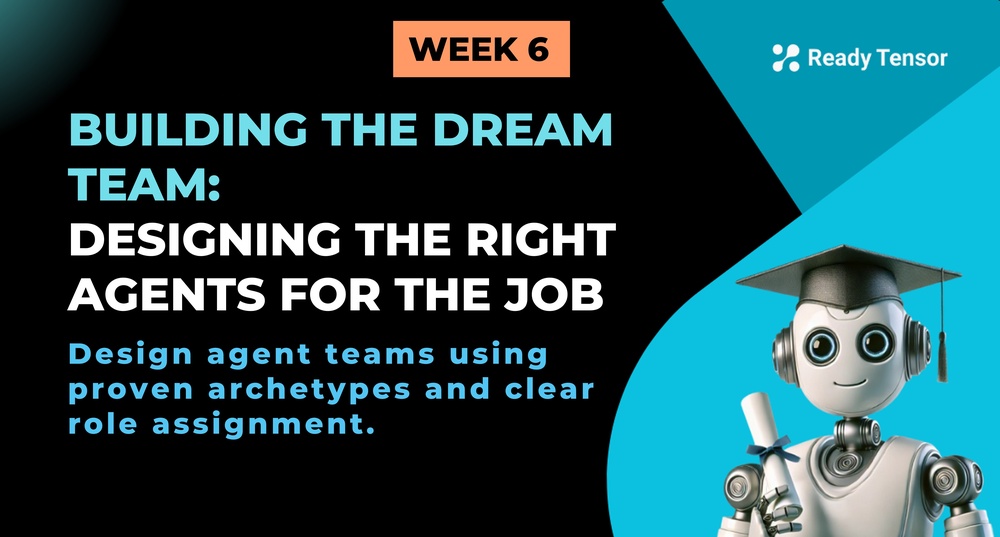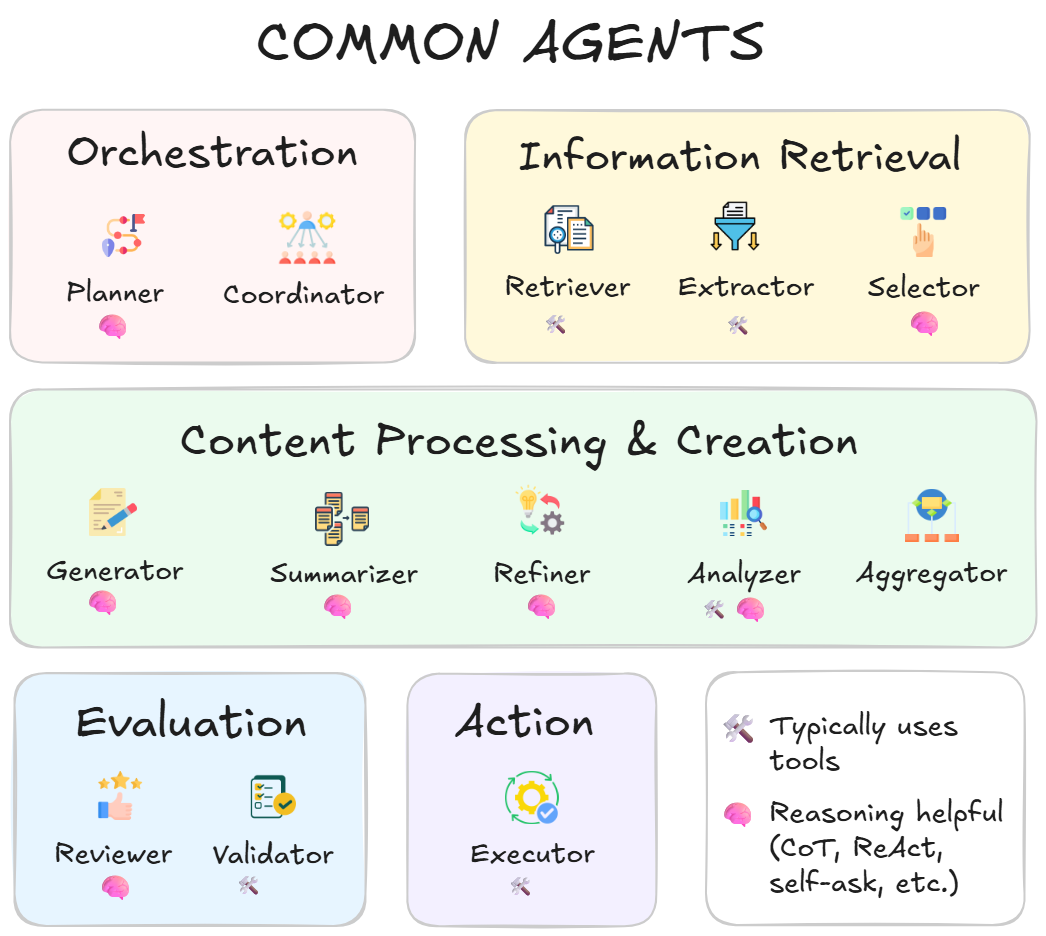
⬅️ Previous - Tag Extraction System
➡️ Next - Design Agentic Authoring System
Part 1 of 2: Great agentic systems start with the right agents doing the right work. In this lesson, you'll learn how to map the essential work first, then design skill-based agents to handle it cleanly. You'll discover common agent archetypes (from Retrievers to Validators), avoid the traps of micro-agents and mega-agents, and ensure every piece of work is covered without overlap. Part 2 will cover how to make these agents work together effectively.
In the last two lessons, we walked through the scope and implementation of the tag extraction system. As you followed along, you may have wondered:
In this lesson, we’ll share our answers — not just theoretical best practices, but practical guidance drawn from experience. You’ll learn how to scope agent responsibilities, avoid common mistakes, and build agent teams that actually collaborate — instead of stepping on each other’s toes.
Let’s get into it.
Before we dive into roles, responsibilities, and design patterns, let’s be clear about what matters most: your job is to solve the problem.
That’s your North Star. Not elegant architecture diagrams. Not maximizing the number of agents. Not showcasing your graph-building skills.
Just build something that works — that gets the job done cleanly, reliably, and with minimal complexity.
That said, design patterns and best practices exist for a reason. They don’t guarantee success, but they can help you avoid common pitfalls, reduce fragility, and make your system easier to debug, extend, or reuse.
So don’t treat patterns like rules — treat them like guardrails. Let your problem drive the architecture, not the other way around.
Before deciding which agents to build, start with a simple question:
What needs to happen for this system to deliver value?
We call this mapping the knowledge work — identifying the actual steps required to go from input to output. Not who does them, but what gets done.
Forget agent boundaries for now. Focus on the essential work:
Only once you’ve mapped this value path should you start designing the agentic system.
The goal isn’t to maximize agents — it’s to cover the right capabilities cleanly.
When designing agentic systems, people often fall into one of two traps:
Both sound structured. Both usually fall apart.
Let’s say you’re building a References Generator — a system that takes a project description and returns a list of relevant papers, online articles, or blog posts. You might start by splitting the process:
Each step becomes its own agent. You end up with a dozen tiny agents, all hard-coded to a specific function.
Sure, it works. But the result is:
Take a “Web Search Agent.” If tomorrow you want to support arXiv, Google Scholar, or a custom database — do you build new agents for each?
Or do you build one smart retriever agent and give it the tools it needs?
That’s the difference between hard-coding and modular design.
And when you move on to something like a Literature Review Assistant, the first few steps — extract concepts, search, filter — are exactly the same.
If your agents are modular, you reuse them.
If they’re overfitted, you start over.
On the flip side, defining agents by job titles feels intuitive — but often leads to:
What does a “Researcher Agent” really do? Is it searching? Filtering? Scoring? Summarizing? Fact-checking? All of the above?
If it’s doing too much, it’s doing too little of it well.
So what's the alternative? Focus on skills, not tasks or titles.
Some capabilities show up everywhere — retrieving information, filtering results, judging relevance, or summarizing content. These are the building blocks you'll use across projects.
Build agents around these core skills. Make them flexible through prompt injection and structured inputs. Then compose them into workflows as needed.
Your "Web Search Agent" becomes a "Retrieval Agent" that can search the web, query databases, or scan documents. Your “Reference Picker” becomes a Selection Agent that can rank papers, choose the best tags, or filter top results in any domain given the right context.
Not every agent needs to be generalized — some will be specific to your use case. But when you spot these recurring skills, design for flexibility and re-use.
Let's look at the most common ones.
When building agentic systems, certain roles come up again and again. Instead of designing agents from scratch each time, it helps to think in terms of reusable skills — like retrieving information, generating content, or validating outputs.
Below are the most common agent types, organized by function. These are your core building blocks — modular, composable, and useful across many systems.

These agents manage flow and structure.
These agents gather and organize relevant inputs.
These agents transform or synthesize content.
These agents judge and improve quality.
These agents trigger effects beyond the system.
By now, you’ve done the groundwork. You’ve clarified the problem, mapped the key work involved, identified the core skills required, and chosen the agents to match.
Now comes the important next step:
Assign that work cleanly — and make sure every piece is covered.
This is where things can go wrong if you’re not careful. Even with the right agents in hand, it’s easy to:
Let’s look at how to spot those before they trip you up.
Let’s say you’re building a system that pulls external content into an article:
Sounds reasonable — until you look closer.
Web pages are full of clutter: ads, headers, unrelated text. Even your “best” results still contain noise. If you pass those raw into the Generator, you’re setting it up to fail.
What’s missing? A Summarizer or Refiner to clean and compress the selected results before generating anything.
That’s a gap. A skill your system needs — but doesn’t have.
Now imagine you’ve assigned both a Summarizer and a Refiner to process the same text.
Do you need both? Or is one doing the other’s job?
Overlaps create unnecessary complexity — and make debugging painful.
Walk through your system and ask:
Mapping the flow helps catch what’s missing — and what’s unnecessary.
So now you've mapped the whole system: the knowledge work is covered, the agents are clearly defined, and the value path flows from start to finish.
Tempted to string it all into one neat sequence?
Hold up.
Just having the right agents in the right order doesn’t guarantee a working system. In agentic AI, collaboration matters — and that means thinking beyond just who does what.
To make your system robust and reliable, you’ll need:
In other words: good agents need a good playbook. Without it, you'll face coordination breakdowns, cascade failures, and the kind of multi-agent chaos that makes debugging a nightmare.
We’ll cover all of that in Part 2.
Building the Dream Team: Making Agents Work as a Team
How to coordinate agents, structure collaboration, and build systems that hold up under pressure.
⬅️ Previous - Tag Extraction System
➡️ Next - Design Agentic Authoring System